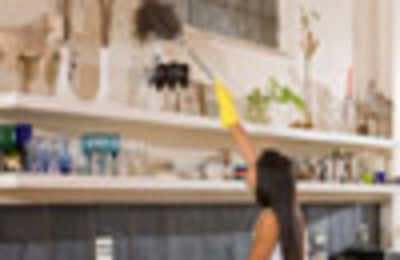- News
- lifestyle
- home-garden
- Some quick-fix 'do-it-yourself' tips
Trending
This story is from February 28, 2015
Some quick-fix 'do-it-yourself' tips
Stop waiting around for men to help you with simple handiwork around the house. Here are some quick-fix DIY tips to help you do your own repair work

Stop waiting around for men to help you with simple handiwork around the house. Here are some quick-fix DIY tips to help you do your own repair work
It's easy to kick back and rely on your husband/boyfriend or trusty old dad to help you out when things go wrong around the house. But let's face it, it's not doing much for your independence, is it? And what about when they're not around and you're all by yourself.
It isn't rocket science. It's just a little know-how, a little technique. If they can do it, so can you. Here are some simple tricks to show you how it’s done.
De-stink your sinks Unblocking a sink is one of the easiest and cheapest DIY jobs. Pour two to three tablespoons of bicarbonate of soda down the plug hole, followed by some glugs of vinegar — supermarket brands are fine. Then simply flush through with hot water. Voila.
Reseal bath tiles Guaranteed to impress friends and family, but quite a time-consuming task. As soon as black mould starts to appear around your bathroom tiles and commode, use a utility knife to cut out the old sealant between tiles. Clean the area with white spirit and wait until dry. Then, using a nozzle attached to a long tube (easily found at any hardware store), slowly apply a silicone sealant or white plaster of paris, cheaply available. Keep consistent pressure on the tube and don’t let it form lumps.
Once you have placed an even bead round the tiles, smoothen it using your fingers or a flat wood board. Keep the bathroom dry for atleast 10 to 12 hours after applying the sealant as to get it aptly dry.
Cleaning taps of limescale Use the trusty bicarbonate of soda and vinegar combo again — a couple of tablespoons of bicarb to one tablespoon of vinegar mixed in a plastic bag. Tie the bag over the taps, ensuring the ends are dipped in the solution. Leave for two to four hours and scrub off with an old toothbrush.
Use a power drill Before you start drilling, practice in thin air and then on some scrap material like old wood. For stronger surfaces, such as brick, you'll need a hammer drill and a masonry drill bit. For softer services use a wood bit and take the drill off hammer setting. Start with a smaller hole and work it up.
Paint a window External windows and doors need to be painted regularly as it protects wood from elements. Scrape away any flaky paint, sand back the area, fill any holes with wood filler and sand again.
Clean the area and apply paint with a small, one-inch brush. Don’t overload the brush and don’t overwork the paint. Work slowly and methodically and your windows will look pretty as a picture.
Re-oil wood surfaces, doors or tables Kitchen tables or bedroom doors looking a bit lack-lustre? Like all natural products, they just need a good feed. Ensure the wood is clean and sand away any nasty marks or chips. Wipe the surface with white spirit or a tack cloth (a sticky cloth or roll of sticky paper available at a hardware and stationery stores) is great for picking up lint) to banish dust. Pour some oil (a hardware store can point you towards a good one) on a lint-free cloth. Work into the wood and follow the grain. Wait until it’s dry and apply another coat. Ta-da... all done.
It's easy to kick back and rely on your husband/boyfriend or trusty old dad to help you out when things go wrong around the house. But let's face it, it's not doing much for your independence, is it? And what about when they're not around and you're all by yourself.
It isn't rocket science. It's just a little know-how, a little technique. If they can do it, so can you. Here are some simple tricks to show you how it’s done.
De-stink your sinks Unblocking a sink is one of the easiest and cheapest DIY jobs. Pour two to three tablespoons of bicarbonate of soda down the plug hole, followed by some glugs of vinegar — supermarket brands are fine. Then simply flush through with hot water. Voila.
For really stubborn sinks If your sink still isn’t playing ball, you’ll need a more drastic action. Place a bucket under the sink and start dismantling the U-bend. You won’t need tools as all the connections will be hand-tightened. Wash the U-bend in another sink and reassemble. To prevent a big mess, keep some old clothes and a nose peg handy in case of smells and spillages.
Reseal bath tiles Guaranteed to impress friends and family, but quite a time-consuming task. As soon as black mould starts to appear around your bathroom tiles and commode, use a utility knife to cut out the old sealant between tiles. Clean the area with white spirit and wait until dry. Then, using a nozzle attached to a long tube (easily found at any hardware store), slowly apply a silicone sealant or white plaster of paris, cheaply available. Keep consistent pressure on the tube and don’t let it form lumps.
Once you have placed an even bead round the tiles, smoothen it using your fingers or a flat wood board. Keep the bathroom dry for atleast 10 to 12 hours after applying the sealant as to get it aptly dry.
Cleaning taps of limescale Use the trusty bicarbonate of soda and vinegar combo again — a couple of tablespoons of bicarb to one tablespoon of vinegar mixed in a plastic bag. Tie the bag over the taps, ensuring the ends are dipped in the solution. Leave for two to four hours and scrub off with an old toothbrush.
Use a power drill Before you start drilling, practice in thin air and then on some scrap material like old wood. For stronger surfaces, such as brick, you'll need a hammer drill and a masonry drill bit. For softer services use a wood bit and take the drill off hammer setting. Start with a smaller hole and work it up.
Paint a window External windows and doors need to be painted regularly as it protects wood from elements. Scrape away any flaky paint, sand back the area, fill any holes with wood filler and sand again.
Clean the area and apply paint with a small, one-inch brush. Don’t overload the brush and don’t overwork the paint. Work slowly and methodically and your windows will look pretty as a picture.
Re-oil wood surfaces, doors or tables Kitchen tables or bedroom doors looking a bit lack-lustre? Like all natural products, they just need a good feed. Ensure the wood is clean and sand away any nasty marks or chips. Wipe the surface with white spirit or a tack cloth (a sticky cloth or roll of sticky paper available at a hardware and stationery stores) is great for picking up lint) to banish dust. Pour some oil (a hardware store can point you towards a good one) on a lint-free cloth. Work into the wood and follow the grain. Wait until it’s dry and apply another coat. Ta-da... all done.
End of Article
FOLLOW US ON SOCIAL MEDIA









